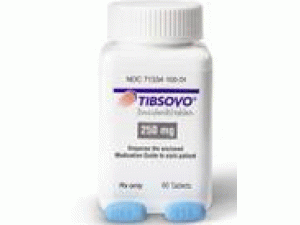艾伏尼布,艾伏尼布Tibsovo Tablets 250mg(ivosidenib)
 药店国别:无
产地国家:美国
处方药:是
所属类别: 250毫克/片 60片/瓶
包装规格: 250毫克/片 60片/瓶
计价单位:瓶
生产厂家中文参考译名:无
生产厂家英文名:Agios Pharmaceuticals
原产地英文商品名:Tibsovo 250mg/tablets 60tablets
原产地英文药品名:
中文参考商品译名:Tibsovo 250毫克/片 60片/瓶
中文参考药品译名:ivosidenib
曾用名:无
药店国别:无
产地国家:美国
处方药:是
所属类别: 250毫克/片 60片/瓶
包装规格: 250毫克/片 60片/瓶
计价单位:瓶
生产厂家中文参考译名:无
生产厂家英文名:Agios Pharmaceuticals
原产地英文商品名:Tibsovo 250mg/tablets 60tablets
原产地英文药品名:
中文参考商品译名:Tibsovo 250毫克/片 60片/瓶
中文参考药品译名:ivosidenib
曾用名:无
简介
近日,FDA批准新抗癌药Tibsovo(ivosidenib)片用于治疗携带一种特定基因突变的复发性或难治性急性髓性白血病(AML)成人患者。这是首个IDH1抑制剂类药物,其获批的同时,一款伴随诊断试剂也一同获批,用于检测AML患者IDH1基因中的特定突变。 FDA药物评价与研究中心血液学与肿瘤学产品办公室代理主任兼FDA肿瘤优化中心主任、医学博士Pazdur称:Tibsovo是一款靶向药物,它的获批为携带IDH1突变的复发性或难治性AML患者填补了一项未满足的需求。在某些患者中,Tibsovo的使用与完全缓解相关,与对红细胞及血小板的输注需求减少相关。 批准日期:2018年7月20日 公司:Agios PharmaceuticalsTIBSOVO®(ivosidenib)片剂,口服使用 美国最初批准:2018年 警告:差异化综合症查看完整的盒装警告的完整处方信息。 使用TIBSOVO治疗的患者出现了分化综合征的症状,如果不治疗则可能致命。如果怀疑有分化综合征,则启动皮质类固醇治疗和血流动力学监测,直至症状消退。 作用机制 Ivosidenib是一种小分子抑制剂,靶向突变体异柠檬酸脱氢酶1(IDH1)酶。易感IDH1突变被定义为导致白血病细胞中2-羟基戊二酸(2-HG)水平升高的那些突变,其中通过1)临床上有推荐剂量的ivosidenib和/或2)抑制突变IDH1酶活性预测有效性。 根据经验证的方法,在推荐剂量下,ivosidenib浓度可持续。这种突变中最常见的是R132H和R132Cs取代。Ivosidenib在体外以比野生型IDH1低得多的浓度抑制选择的IDH1 R132突变体。在小鼠异种移植模型中,ivosidenib对突变IDH1酶的抑制导致2HG水平降低并诱导体外和体内髓样分化。IDH1突变的AML。在来自具有突变IDH1的AML患者的血液样品中,ivosidenib在体外降低2-HG水平,减少胚细胞计数,并增加成熟髓样细胞的百分比。 适应症和用法 TIBSOVO是一种异柠檬酸脱氢酶-1(IDH1)抑制剂,用于治疗患有复发或难治性急性髓细胞白血病(AML)的成人患者,其具有易感IDH1突变,如FDA批准的检测。 剂量和给药 每天口服500毫克,含或不含食物,直至疾病进展或不可接受的毒性。避免高脂肪餐。 剂量形式和强度片剂:250mg。 禁忌症:没有。 警告和注意事项 QTc间期延长:监测心电图和电解质。如果发生QTc间期延长,剂量减少或保留,则恢复剂量或永久停止TIBSOVO。 格林 - 巴利综合征:监测患者的新运动和/或感觉发现的体征和症状。在被诊断患有格林 - 巴利综合征的患者中永久停用TIBSOVO。 不良反应 最常见的不良反应(≥20%)是疲劳,白细胞增多,关节痛,腹泻,呼吸困难,水肿,恶心,粘膜炎,心电图QT延长,皮疹,发热,咳嗽和便秘。 药物相互作用 强或中等CYP3A4抑制剂:使用强CYP3A4抑制剂降低TIBSOVO剂量。监测患者QTcinterval延长的风险增加。 强大的CYP3A4诱导剂:避免与TIBSOVO同时使用。 敏感的CYP3A4底物:避免与TIBSOVO同时使用。 QTc延长药物:避免与TIBSOVO同时使用。 如果共同给药是不可避免的,监测患者QTcinterval延长的风险增加。 用于特定人群哺乳期:建议女性不要母乳喂养。 如何提供/存储和处理 如何提供250mg片剂:蓝色椭圆形薄膜包衣片在一侧凹陷“IVO”,在另一侧凹陷“250”。含有干燥剂罐的60粒250毫克片剂(NDC 71334-100-01)存储储存在20°C至25°C(68°F至77°F); 允许的偏差在15°C至30°C(59°F至86°F)之间[见USP受控室温]。英文版说明
TIBSOVO® (ivosidenib) is indicated for the treatment of adult patients with relapsed or refractory acute myeloid leukemia (AML) with a susceptible isocitrate dehydrogenase-1 (IDH1) mutation as detected by an FDA-approved test.IMPORTANT SAFETY INFORMATIONWARNING:DIFFERENTIATION SYNDROMEPatients treated with TIBSOVO have experienced symptoms of differentiation syndrome, which can be fatal if not treated. Symptoms may include fever, dyspnea, hypoxia, pulmonary infiltrates, pleural or pericardial effusions, rapid weight gain or peripheral edema, hypotension, and hepatic, renal, or multi‑organ dysfunction. If differentiation syndrome is suspected, initiate corticosteroid therapy and hemodynamic monitoring until symptom resolution.WARNINGS AND PRECAUTIONSDifferentiation Syndrome: See Boxed WARNING. In the clinical trial, 19% (34/179) of patients with relapsed or refractory AML treated with TIBSOVO experienced differentiation syndrome. Differentiation syndrome is associated with rapid proliferation and differentiation of myeloid cells and may be life-threatening or fatal if not treated. Symptoms of differentiation syndrome in patients treated with TIBSOVO included noninfectious leukocytosis, peripheral edema, pyrexia, dyspnea, pleural effusion, hypotension, hypoxia, pulmonary edema, pneumonitis, pericardial effusion, rash, fluid overload, tumor lysis syndrome, and creatinine increased. Of the 34 patients who experienced differentiation syndrome, 27 (79%) recovered after treatment or after dose interruption of TIBSOVO. Differentiation syndrome occurred as early as 1 day and up to 3 months after TIBSOVO initiation and has been observed with or without concomitant leukocytosis.If differentiation syndrome is suspected, initiate dexamethasone 10 mg IV every 12 hours (or an equivalent dose of an alternative oral or IV corticosteroid) and hemodynamic monitoring until improvement. If concomitant noninfectious leukocytosis is observed, initiate treatment with hydroxyurea or leukapheresis, as clinically indicated. Taper corticosteroids and hydroxyurea after resolution of symptoms and administer corticosteroids for a minimum of 3 days. Symptoms of differentiation syndrome may recur with premature discontinuation of corticosteroid and/or hydroxyurea treatment. If severe signs and/or symptoms persist for more than 48 hours after initiation of corticosteroids, interrupt TIBSOVO until signs and symptoms are no longer severe.QTc Interval Prolongation: Patients treated with TIBSOVO can develop QT (QTc) prolongation and ventricular arrhythmias. One patient developed ventricular fibrillation attributed to TIBSOVO. Concomitant use of TIBSOVO with drugs known to prolong the QTc interval (e.g., anti-arrhythmic medicines, fluoroquinolones, triazole anti‑fungals, 5‑HT3 receptor antagonists) and CYP3A4 inhibitors may increase the risk of QTc interval prolongation. Conduct monitoring of electrocardiograms (ECGs) and electrolytes. In patients with congenital long QTc syndrome, congestive heart failure, electrolyte abnormalities, or in those who are taking medications known to prolong the QTc interval, more frequent monitoring may be necessary.Interrupt TIBSOVO if QTc increases to greater than 480 msec and less than 500 msec. Interrupt and reduce TIBSOVO if QTc increases to greater than 500 msec. Permanently discontinue TIBSOVO in patients who develop QTc interval prolongation with signs or symptoms of life-threatening arrhythmia.Guillain-Barré Syndrome: Guillain-Barré syndrome occurred in <1% (2/258) of patients treated with TIBSOVO in the clinical study. Monitor patients taking TIBSOVO for onset of new signs or symptoms of motor and/or sensory neuropathy such as unilateral or bilateral weakness, sensory alterations, paresthesias, or difficulty breathing. Permanently discontinue TIBSOVO in patients who are diagnosed with Guillain-Barré syndrome.ADVERSE REACTIONS•The most common adverse reactions (≥20%) of any grade were fatigue (39%), leukocytosis (38%), arthralgia (36%), diarrhea (34%), dyspnea (33%), edema (32%), nausea (31%), mucositis (28%), electrocardiogram QT prolonged (26%), rash (26%), pyrexia (23%), cough (22%), and constipation (20%).•The most frequently reported ≥Grade 3 adverse reactions (≥5%) were electrocardiogram QT prolonged (10%), dyspnea (9%), leukocytosis (8%), tumor lysis syndrome (6%), and differentiation syndrome (5%).•Serious adverse reactions (≥5%) were differentiation syndrome (10%), leukocytosis (10%), and electrocardiogram QT prolonged (7%). There was one case of progressive multifocal leukoencephalopathy (PML).DRUG INTERACTIONSStrong or Moderate CYP3A4 Inhibitors: Reduce TIBSOVO dose with strong CYP3A4 inhibitors. Monitor patients for increased risk of QTc interval prolongation.Strong CYP3A4 Inducers: Avoid concomitant use with TIBSOVO.Sensitive CYP3A4 Substrates: Avoid concomitant use with TIBSOVO.QTc Prolonging Drugs: Avoid concomitant use with TIBSOVO. If co-administration is unavoidable, monitor patients for increased risk of QTc interval prolongation.LACTATIONMany drugs are excreted in human milk and because of the potential for adverse reactions in breastfed children, advise women not to breastfeed during treatment with TIBSOVO and for at least 1 month after the last dose.Please see full Prescribing Information, including Boxed WARNING.file:///C:/Users/Administrator/AppData/Local/Microsoft/Windows/Temporary%20Internet%20Files/Content.IE5/B8K3H79F/prescribinginformation.pdf用药温馨提示:当您服用此药物时,需定期接受医疗专业人士的检查,以便随时针对其药效、副作用等情况进行监测。本网站所包含的信息旨在为患者提供帮助,不能代替医学建议和治疗。
药品价格查询,专业药品查询网站,药品说明书查询,药品比价 » 艾伏尼布,艾伏尼布Tibsovo Tablets 250mg(ivosidenib)
药品价格查询,专业药品查询网站,药品说明书查询,药品比价 » 艾伏尼布,艾伏尼布Tibsovo Tablets 250mg(ivosidenib)


